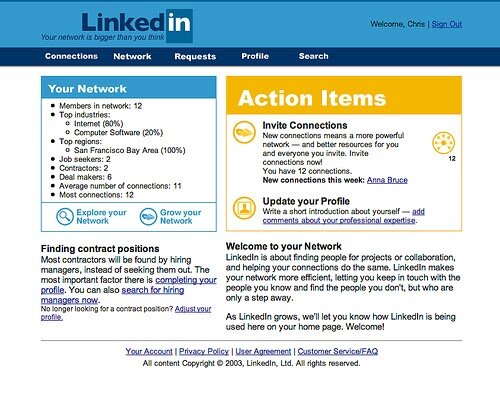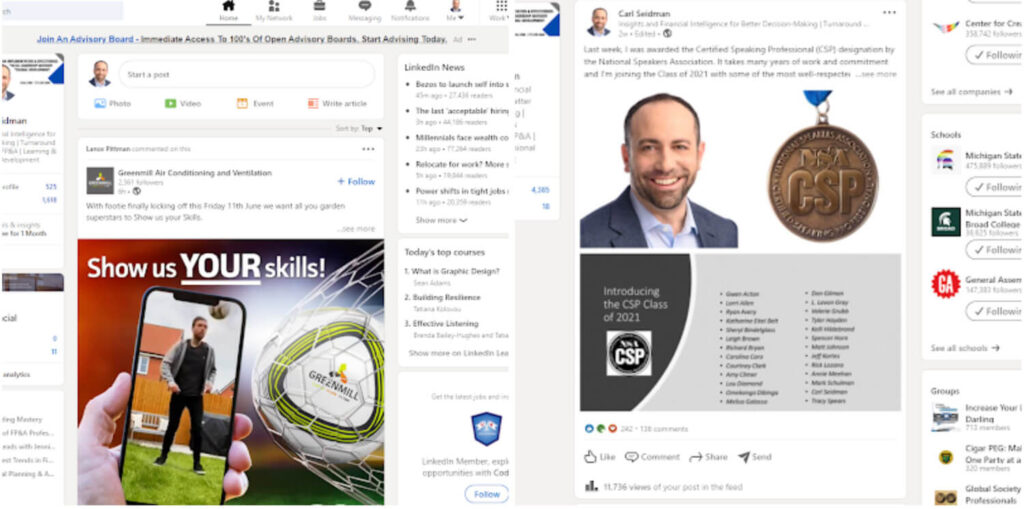How to Use LinkedIn to Propel Business, Relate to Clients, and Stay Current In Your Field
I’ve never been one to enjoy large networking events. For years, I’d gone to conferences, masterminds, fundraisers, and roundtables. And while these in-person meetings and experiences allowed me to meet new people, they rarely facilitated deeper connections. To go deeper, and to inform and update people on personal and business developments, I’ve spent countless hours meeting people for coffee and lunch, on the phone and writing emails. I’m still convinced one-on-one is the way to go.
But in recent years, the busyness of work and the responsibility of parenting young kids — not to mention the challenges set forth by COVID — has made one-on-one engagement and in-person events more challenging. Time is limited, attention is sparse, and people are busy. I continue using Zoom more frequently than an average person, sometimes getting on calls back-to-back throughout the day, but I’ve become far more intentional about what I do with my time and how I engage with people.
At the risk of becoming less personal, I’ve begun to spend more time on LinkedIn than ever before. In my opinion, there is no better medium for connecting with talent, experts, prospects, and friends than on this vast social media platform focused on business professionals and interactions.
Before I get into explaining how I used LinkedIn, let me share a little bit of history:
- LinkedIn launched into the early social media scene in 2003 - co-founder Reid Hoffman also played a major role in other early technologies like Google, Paypal, and eBay.
- LinkedIn is older than Facebook, Twitter and YouTube.
- The original mission statement was to connect the world’s professionals to make them more successful and productive.
- Microsoft bought LinkedIn for $26.2-billion in 2016.
Source: https://thelinkedinman.com/history-linkedin/
I was among the first people to join LinkedIn, having done so in college and when other social media sites were just getting started. Some of you might not remember what LinkedIn looked like at its inception. Let me refresh your memory:

In the early days – at least for me – there wasn’t much of a point to LinkedIn. Just like Facebook, MySpace and Friendster, LinkedIn hadn’t figured out what it was meant to do nor how to monetize its business model. I’d argue that LinkedIn had no business mode. There wasn’t much activity, there were no news-feeds, there wasn’t a sharing of knowledge, there were no training options. You’d post your resume and check in once a month or so. LinkedIn was a bit of a “set it and forget it” platform and little more than a way to establish a two-way virtual connection with people in your network.
Today, LinkedIn has become an invaluable tool, not only for job seekers and recruiters, but for everyone in business. There are now approximately 740 million members. In a largely virtual world – increasingly more so now since COVID’s emergence – networking has changed. LinkedIn is one giant networking event that never ends (arguably, for better and for worse). For many, LinkedIn is the new networking event and has taken the place of after-work happy hours, roundtables, and conferences.
While I do miss the food and beverage at the networking events I used to attend, I’m increasingly grateful for the technology LinkedIn provides and the geographic barriers it removes. I’m now able to post original thoughts and ideas and see who’s engaging with them, comment in groups, identify prospects and other interesting people, enroll in training courses, message contacts and strangers directly, update my network on my business developments, and so much more. I make it a point to invest time each day, multiple times a day, connecting with others and creating content to share.
Contrast the above visual with this one below. This is what my LinkedIn feed, interface and profile look like now:

Rather than just focus on what LinkedIn offers its users, and not be overwhelmed in such a sea of users and functionality, I want to share with you several best practices I’ve adapted when it comes to building my network and advancing my own profile:
Don’t connect just for the sake of connecting
I have over 4,300 connections on LinkedIn. While that may sound like a lot, I’m certain that I’ve connected personally with most of these individuals. Some have been in my training programs, many are past colleagues, and hundreds have been clients. In addition, almost daily, I receive connection requests from people who follow my content or have been notified of my activity through mutual connections. Of course, there are the frequent requests-to-connect from people who want to sell to me and I can usually screen them out, block them, or disconnect from them if they aggressively sell to me.
I’ve changed my tune over the years. While I think it’s the norm to see a connection request and automatically accept with the intention of growing a professional network, that may not always be the best route to take. Unless someone has a legit message for you, lives in your area, or works directly in your related field, I’d encourage you to only connect with those you know, want to know or be connected with, or are acquainted with outside of the internet. This will pay off in the long run by helping you to build legitimate connections you can rely on.
The reason I suggest not connecting with everyone is multifold. One, contacts may begin to ask: “Hey, how do you know so-and-so?” You may not have an answer. And while it’s not uncommon for users to accept requests from everyone, it’s better to be a reliable referral source or networker than someone who connects for the sake of increasing their numbers. Two, quality connections far outweigh a quantity of connections. Engagement with your content is stronger when people know who you are and value what you do. Likes and comments on your posts from total strangers don’t usually translate into greater engagement on the network. I have posts with very few likes and comments yet thousands of impressions; I also have posts with dozens of likes and comments with a mere few hundred impressions. Great engagement from influential people in your network is what has the greatest impact on your message reaching eyeballs. LinkedIn algorithms don’t put garbage content in front of your entire network, even if you have tens of thousands of connections.
Finally, connecting with the right people allows you to keep in touch with people no matter where they move professionally. This is why LinkedIn is such a remarkable resource. Decades ago, you’d leave a job and quickly lose touch with the people you once spent your entire days with. That’s no longer the case. Jobs change. Contact information changes. People move. LinkedIn makes it easy and accessible to not only grow your network but to keep your past intact. That’s something that makes a big difference on a day-to-day basis for millions of people.
Just say no to humble posts, promotional items, and sales tactics
If you’re posting something on Facebook or Instagram, chances are good it’s not the right content for LinkedIn. There are exceptions to this rule of course (promotions, retirements, degrees), but LinkedIn is generally not the place to gloat, show off, or post politically inflammatory messages. Instead, follow a simple rule: Create content that people want to see and engage with. In other words, share thoughts and ideas that aren’t Google-able.
Post genuine ideas, original thoughts, candid conversations, helpful video….that which is genuinely interesting and USEFUL to your community. That’s not always an easy task but it will make an incredible difference in building an engaged community. I’ve posted about everything from education to entrepreneurship, commenting on companies like Peloton and even Tinder. I often reflect on global issues like the pandemic as well as those close-to-home like working remotely and starting out in business. Everything is fair game and I believe my connections and readers are interested because I make it a priority to have something new to say on a regular basis. I don’t post for the sake of posting — I post when I have something my connections will find interesting or informative.
Sometimes posting authentic messages can mean I have to put risky ideas out into the world or go against the grain of what others are safely saying, but this is a gamble I’m willing to take in order to share new ideas and make meaningful connections.
Take connection a step further
Here’s where LinkedIn’s technology, specifically their algorithms, help me to “meet” the people who are continually viewing and engaging with my content. Knowing who these people are helps me to build an avatar (or a profile) of my ideal clients and fans. Who should I be talking to? What is their background? How can I find others like these who are engaged in the information I put online? These are the people I want to be in front of. That’s information I want to have. And I have LinkedIn to thank for showing me who cares about what I’m saying.
There have been many times I’ve noticed a person engaging consistently and I’ve messaged them to start a conversation offline. For example, two finance professionals — one named Paul and one named James — constantly commenting on my posts. Relationships don’t form in a comment over a post. Eventually, I directly messaged them and said “it looks like we have a lot in common, let’s take this offline.” Ironically, offline means talking over Zoom (which, yes, is still technically online — so I suppose I should say “let’s take this off of LinkedIn”). We’ll talk over Zoom and share more about who we are, in business – and in life. I’m not taking the time to sell them anything. It’s not a promotional tactic, but a relationship building activity. Thanks to this practice, I now have connections in Singapore, the Middle East, the UK and beyond. James and I have formed a collaboration and have assisted each other on pitches. He also granted me a license to train myself on Anaplan. With Paul, he’s been pivoting in his career and I’ve offered to help connect him to resources that might be valuable. Months or years after starting these friendships, I’ve earned trust and have demonstrated my expertise. In some cases, I get referrals for speaking engagements or to new clients.
The moral of this story
Putting yourself out there and sharing your truth with the world is what your network wants to see. Authenticity pays off more so than trying to hack algorithms, take shortcuts, and copy what others are doing. This is true in real life and online. A willingness to spend a portion of your valuable time sharing YOUR ideas and making genuine connections is time well spent and I’m willing to bet it will pay off.






